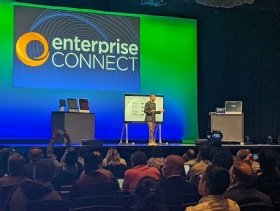
Getty Images/iStockphoto
Cisco bolsters Webex flexibility as hybrid work looms
Cisco said companies must have the flexibility to let employees work how and where they want. Hybrid work features for Webex will provide employees with more choices.
Cisco will add Apple Airplay support to its Webex devices and let Ford cars connect to Webex meetings, saying hybrid work will require companies to accommodate many workstyles and workspaces.
At the company's Enterprise Connect keynote address, Cisco executives said the move to hybrid work would be a massive transition from how firms did business during the pandemic. Without flexibility, companies will not be able to take advantage of hybrid work's productivity and worker-retention benefits.
"The danger is that people go back to the old way of doing things," said Javed Khan, a senior vice president at Cisco. "It would be a tragedy if we were to lose the productivity gains of the last two years."
The integration with Apple Airplay will let iPad, iPhone and Mac users share content to Webex devices more easily. With Airplay, workers can share their screens on conference room displays, use a Webex Desk as a second monitor, or play music on Webex devices. The feature will be available in June.
"My office playlist just got so much better," Khan said of the Apple partnership.
Cisco also announced a partnership to bring Webex meetings to Ford cars. Drivers would be able to use the Ford Sync communications and entertainment system to join calls from their vehicles. The calls will be audio-only while the automobile is in motion but may use video when the car is parked, Khan said. Cisco will release the capability by the end of the year.

The features are part of Cisco's push to accommodate employee workstyles and workspaces post-pandemic. Hybrid work will force businesses to adapt to employee needs or risk losing them. According to a PwC survey, 55% of 1,200 office workers surveyed preferred to work remotely at least three days a week.
"To attract and retain prized workers, organizations must better align with workers' desires and values, including how, where and when to work," Cisco executive vice president Jeetu Patel said in a statement.
Cisco plans to add capabilities to its asynchronous video product, Vidcast, which the company launched last year. The upcoming feature will let workers import, edit and share video from Webex.
Also, employees will have the option of embedding Vidcast videos in Slido audience polls and events held in Webex. The company believes asynchronous video can free employee schedules and reduce meeting fatigue by letting workers decide when they view the content.
"I just don't have enough hours in the day" for every meeting, Khan said.
Asynchronous video can also help companies with a global workforce. When a company has teams in India, China and Europe, there is no right time for an all-hands call, Khan said. With asynchronous video, businesses can get the same message to all their employees without scheduling a meeting at inconvenient hours.
The features that Cisco announced were interesting, but other things matter more, said Neskens Meritil, an audio-visual technician at law firm Ropes & Gray. He said Cisco's promise that Webex devices work with Microsoft Teams, Zoom and Google Meet is much more impactful to him, as he has to ensure workers can use their video conferencing service of choice.
Mike Gleason is a reporter covering unified communications and collaboration tools. He previously covered communities in the MetroWest region of Massachusetts for the Milford Daily News, Walpole Times, Sharon Advocate and Medfield Press. He has also worked for newspapers in central Massachusetts and southwestern Vermont and served as a local editor for Patch. He can be found on Twitter at @MGleason_TT.






